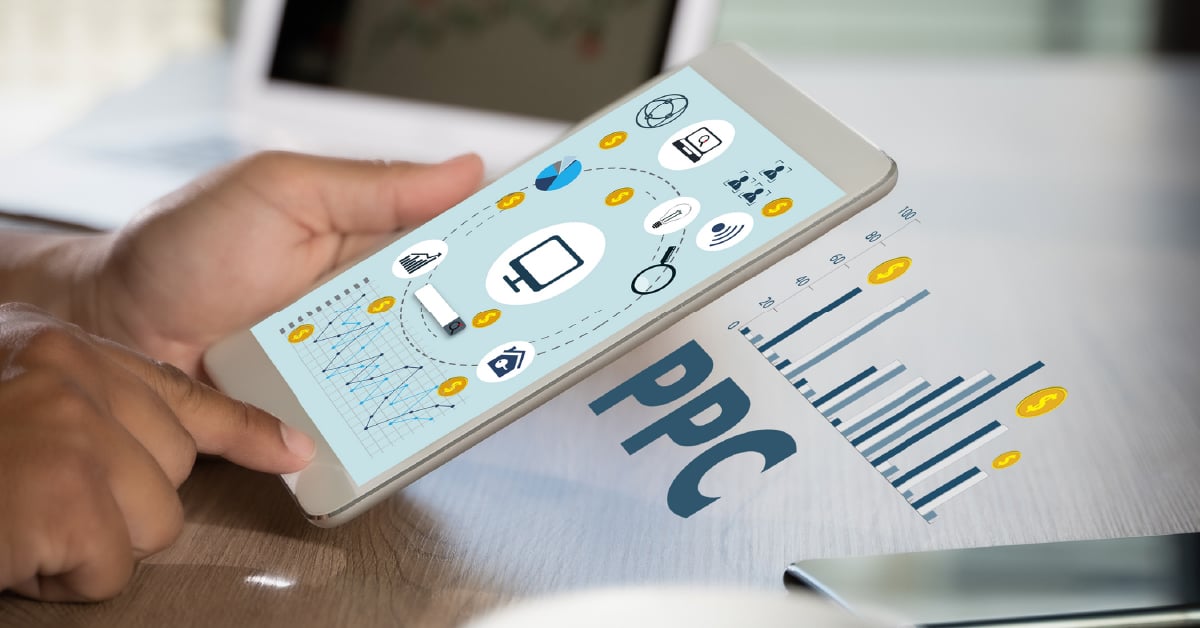Digital advertising continues to dominate the marketing landscape. In 2025, digital channels now account for over 75% of worldwide advertising spend, reaching more than $750 billion. Businesses value the measurability that digital marketing delivers compared to traditional channels. Digital marketing can be a powerful way to grow your business, but before you invest, you need to understand the key terms and metrics that matter.
The 11 most important digital marketing terms

Whether you're just getting started or looking to sharpen your digital marketing knowledge, these terms form the foundation of successful campaigns.
1. Landing pages
The landing page is where users go after they click your ad. If you're sending clicks directly to your homepage, you're missing a huge opportunity.
Your landing page should align perfectly with the ad that drove the click. Users expect customization — if your ad talks about different types of shoes you sell, your landing page should showcase those exact shoe categories. The simple act of matching your landing page to your ad copy can dramatically increase your digital marketing success.
When evaluating your landing pages, focus on conversions. According to recent industry data, conversion rate benchmarks vary significantly by industry, with medians ranging from 3.8% for SaaS to 12.3% for legal services. Understanding where your landing pages fall within your industry's benchmarks helps you identify opportunities for improvement.
2. PPC (pay-per-click)

Pay-per-click advertising is exactly what it sounds like — a payment method where advertisers pay each time someone clicks their ad. This pricing model is common for paid search campaigns through Google Ads and Bing, as well as on social media platforms like Facebook, Instagram, and LinkedIn.
Crafting compelling ads that entice users to take action can generate significant traffic to your website. The key is finding the right balance, understanding your goals, and continually measuring progress. Most PPC operates on bidding, meaning you set a maximum cost per click based on your budget and objectives.
One of the primary benefits of PPC advertising is that you only pay when someone clicks your ad. Every time your ad is shown (served an impression), it's free. You're essentially promoting your brand at no cost until someone engages, and there's real value in having your brand visible to potential customers.
3. Conversions
A conversion represents a desired action taken by a user after engaging with your marketing. The journey typically looks like this: 1) You create a compelling ad, 2) A user clicks through to your website, 3) Your landing page provides the information they're seeking, 4) The user takes a meaningful next step.
Common conversion examples include:
- Filling out a contact form
- Downloading an ebook or case study
- Making an online purchase
- Clicking for directions to your physical location
- Scheduling a consultation or demo
4. Conversion rate
This is measured as a percentage of visitors to your website or a landing page that completes a conversion. The formula for calculation is: Form Submissions + Tracked Calls / Total Website or Landing Page Visitors = Conversion Rate.
For Google Ads specifically, the average conversion rate in 2025 is 7.52%, though this varies dramatically by industry. Industries like automotive repair and veterinary services see conversion rates above 13%, while furniture and real estate typically convert below 4%. When evaluating your performance, always compare yourself to your specific industry benchmarks rather than overall averages.
5. Programmatic advertising
Programmatic advertising uses artificial intelligence and automated bidding to buy and place digital ads in real-time. By 2027, algorithm-driven ad spend is forecast to reach 78.1% of total advertising expenditure. Rather than targeting broad demographics, programmatic advertising can target specific individuals based on their online behavior, search history, and location.
Our sister company, Leighton Engage, specializes in programmatic advertising. They can place digital ads in front of users who are actively searching for or reading about your products and services using tactics like search retargeting and keyword contextual targeting.
6. KPIs

Great digital marketing starts with clear SMART goals (Specific, Measurable, Achievable, Relevant, Timely). Digital marketing KPIs (Key Performance Indicators) are the benchmarks you track to measure progress toward those goals. Keep in mind, they should be channel-specific.
For social media, you might aim to increase organic post engagement from 4.5% to 5.5% per month by posting more interactive content that links to conversion-optimized landing pages.
For email marketing, your KPIs might focus on delivery rates, open rates, click-through rates, and conversions. Make sure you have a SMART framework in place and that your KPIs measure activities that directly contribute to business goals like revenue growth and customer acquisition.
7. Cost per thousand (CPM)
CPM (cost per mille, or cost per thousand) is both a pricing model and a reporting metric that refers to the cost of 1,000 ad impressions. Many digital advertising platforms base their rates on CPM.
Here are general CPM guidelines for common ad types in 2025:
- Display Ads (Banner): $3–$12 CPM (median $6-8)
- Social Media Ads: $4–$10 CPM, depending on platform and targeting
- Digital Video Ads: $15–$35 CPM
- Connected TV/OTT: $35–$75 CPM
- Mobile In-App: $6–$15 CPM
CPM rates fluctuate based on targeting precision, competition, placement quality, and seasonality (rates typically spike during Q4 holiday shopping).
8. Click-through rate (CTR)

CTR measures the percentage of people who clicked your ad after seeing it. The formula is: Clicks / Impressions = CTR. For example, if 100 people click your ad out of 10,000 impressions, your CTR is 1%.
The average click-through rate across all industries for Google Search ads is approximately 6.66% in 2025. For display ads, the average CTR is much lower at around 0.46%, while social media platforms like Facebook average 1.11% and YouTube averages 0.65%.
Your CTR depends on several factors you can control, including:
- Ad creative and visual appeal
- Relevance to the target audience
- Ad position on the page
- Targeting accuracy
- Compelling calls-to-action
A higher CTR generally indicates your ads are resonating with your audience, but remember that quality clicks matter more than volume — you want clicks from people likely to convert.
However…
Your CTR depends on many factors, but most of them you can control. One factor that can have a big effect on click-through rate is the ad creative, i.e., what your ad looks like, which will play a big part in whether or not users decide to click.
9. ROI & ROAS
These acronyms stand for Return on Investment and Return on Ad Spend. While similar, ROI measures any marketing investment, whereas ROAS specifically tracks digital advertising performance.
Calculating ROAS is straightforward: Revenue Generated by Ad Spend / Total Ad Spend = ROAS. For example, if you spend $1,000 on ads and generate $4,000 in revenue, your ROAS is 4:1 (or 400%).
Since digital advertising tracks performance at every level, you can calculate ROAS for entire campaigns, specific ad sets, or even individual ads. This granular tracking allows you to identify exactly which elements drive results and allocate budget accordingly.
The key consideration is that ROAS requires a direct transaction tied to the ad click — like a product purchase or event registration. Campaigns focused on brand awareness or lead nurturing aren't ideal candidates for ROAS measurement; they require different metrics like reach, engagement, or lead quality scores.
10. Social commerce
Social commerce integrates shopping directly into social media platforms, allowing users to discover and purchase products without leaving their favorite apps. Platforms like TikTok, Instagram, and Facebook are leading this transformation, with social commerce projected to reach $2.9 trillion globally by 2026.
This trend is particularly strong among Gen Z consumers, with 73% reporting they've made purchases directly through social media. The streamlined experience — from product discovery to checkout — removes friction from the buying journey and capitalizes on impulse purchases driven by social proof and influencer recommendations.
Small businesses can leverage social commerce by:
- Setting up Instagram or Facebook shops
- Creating shoppable posts with product tags
- Partnering with micro-influencers for authentic promotion
- Using TikTok Shop to reach younger audiences
- Live-streaming product demonstrations with direct purchase links
11. Marketing automation
A software designed to automate marketing tasks. Common brands of automation software include: Constant Contact (email and social), HubSpot (CRM, CMS, email, and social).
Marketing automation creates efficiencies in marketing tasks and helps streamline customization. For example, an online clothing boutique might use marketing automation software to automate emails based on actions users take on their site.
If a user fills a cart with items but does not complete the transaction, marketing automation software can be used to send an email reminder to the user that their cart is waiting. Using technology like this to personalize engagements and automate the process allows markets to focus on strategy and planning, while execution of tasks can be completed with the help of software.
Putting It All Together
As digital marketing continues to evolve, understanding these fundamental terms helps you make informed decisions about your marketing investments. Small businesses have more tools and opportunities than ever to compete effectively in the digital space. By mastering these core concepts and tracking the right metrics, you can build campaigns that drive real results without wasting precious budget.
We're passionate about helping businesses navigate the digital advertising landscape and make smart, efficient marketing investments. If you have questions after reading this guide, we're here to help!